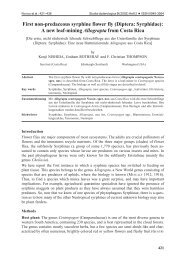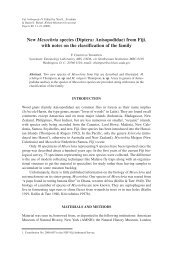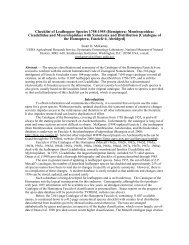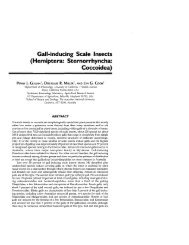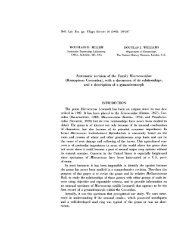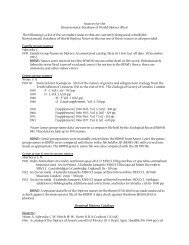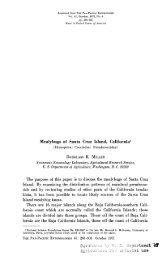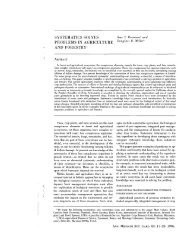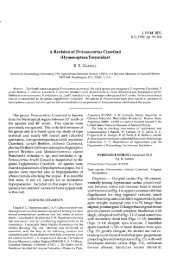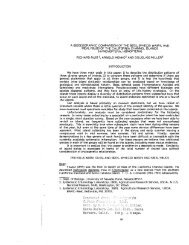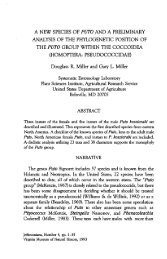Fruit Fly Expert Identification System and Systematic Information
Fruit Fly Expert Identification System and Systematic Information
Fruit Fly Expert Identification System and Systematic Information
You also want an ePaper? Increase the reach of your titles
YUMPU automatically turns print PDFs into web optimized ePapers that Google loves.
Norrbom Status of Knowledge 35<br />
larly modified labella) are unusual in being able to rasp <strong>and</strong><br />
feed on plant tissues (Driscoll & Condon 1994, Condon &<br />
Norrbom 1994). In many fruit flies, both males <strong>and</strong> females<br />
have a premating development period of a week or more during<br />
which they do not mate (Steck 1981, L<strong>and</strong>olt 1984, Williamson<br />
1989).<br />
The appearance of some Tephritidae (e.g., Toxotrypana,<br />
some Anastrepha, some Pseudophorellia, various Adramini<br />
<strong>and</strong> Dacina) strongly suggests that they are wasp mimics, <strong>and</strong><br />
at least in T. curvicauda this is reinforced by behavior (Knab<br />
& Yothers 1914). Other fruit flies with b<strong>and</strong>ed wings <strong>and</strong>/or<br />
spotted abdomens may be jumping spider mimics (Hasson<br />
1995).<br />
Many fruit flies mate on their host plants, but mating tactics<br />
vary, even within some species. Lek formation by males, usually<br />
on nonhosts, has been observed in Ceratitis capitata <strong>and</strong><br />
species of Dacina, Anastrepha, Rhagoletis, <strong>and</strong> Procecidochares<br />
(Prokopy & Hendrichs 1979, Dodson 1986, Sivinski &<br />
Burk 1989, Aluja 1994). Males of most species of Tephritidae<br />
that have been studied secrete some type of sex-attractant<br />
chemical, either by inflating the lateral abdominal membranes<br />
or by extruding an anal pouch (Pritchard 1967, Headrick &<br />
Goeden 1994). They disperse these pheromones by wing fanning,<br />
which also produces sounds of possible significance in<br />
courtship (Sivinski & Webb 1985[4490], Mankin et al. 1996).<br />
Males of many species of Bactrocera <strong>and</strong> Dacus have specialized<br />
structures, including a tibial pad, a microtrichose area of<br />
the wing, <strong>and</strong> a row of setae on the abdomen called the pecten,<br />
which are used for pheromone dispersal (I.M. White, pers.<br />
comm.). The pecten has been proposed as a stridulatory organ<br />
(Monro 1953, Kanmiya 1988). In Anastrepha robusta, the<br />
calling behavior includes short looping flights (Aluja<br />
1993[107]). Visual stimuli, as well as chemical <strong>and</strong> auditory<br />
stimuli, play an important role in communication between <strong>and</strong><br />
among the sexes <strong>and</strong> with other insects. The body, which is<br />
often brightly colored, <strong>and</strong> the wings, which are usually patterned<br />
<strong>and</strong> are often held or moved in particular ways, no doubt<br />
act as releasers. Males of some species engage in antagonistic<br />
displays or bouts (Boyce 1934, L<strong>and</strong>olt & Hendrichs 1983,<br />
Headrick & Goeden 1994), including species of Phytalmia<br />
which have large genal processes used in these bouts (Moulds<br />
1977). Mate-guarding <strong>and</strong> male defense of food resources attractive<br />
to females also have been reported (Hendrichs & Reyes<br />
1987, Headrick & Goeden 1994, Opp et al. 1996).<br />
Courtship can be elaborate in some species, or simple <strong>and</strong><br />
brief in others. Headrick & Goeden (1994) defined 14 movements<br />
or behaviors that commonly occur in courtship, which<br />
may include various types of body, leg, <strong>and</strong> wing movements,<br />
<strong>and</strong>/or transfer of a “nuptual gift” (trophallaxis). The latter<br />
behavior has been observed in diverse taxa, including species<br />
of Dirioxa (Acanthonevrini), Anastrepha (Toxotrypanini), <strong>and</strong><br />
various genera of Tephritinae (Freidberg 1986, Aluja, Jacome<br />
et al. 1993, Headrick & Goeden 1994). The gift may be passed<br />
before or after copulation, <strong>and</strong> it may consist of liquid transferred<br />
by direct contact of the mouthparts (Freidberg<br />
1982[1557], Aluja, Jacome et al. 1993) or may be a solidified<br />
froth deposited on the substrate (Stoltzfus & Foote 1965,<br />
Pritchard 1967, Novak & Foote 1975, Freidberg 1981[1555],<br />
Jenkins 1990). Copulation is determined by female choice<br />
(Headrick & Goeden 1994) <strong>and</strong> may last from several minutes<br />
to several hours or more.<br />
Oviposition behavior appears to be much more uniform<br />
than epigamic behavior <strong>and</strong> consists of the following stages: a)<br />
movement towards <strong>and</strong> arrival at the oviposition site; b) testing<br />
the site; c) drilling with the ovipositor; <strong>and</strong> d) oviposition. In<br />
the case of Anastrepha gr<strong>and</strong>is, which lays a large batch of eggs<br />
in a tough, thick-skinned fruit, this process may last many hours<br />
(Silva 1991). Species in five genera have been reported to<br />
deposit a marking pheromone that deters oviposition by other<br />
females (Prokopy et al. 1976, Averill & Prokopy 1989[247],<br />
Straw 1989[4692]). This involves the female dragging her<br />
aculeus over the substrate, secreting <strong>and</strong> smearing the pheromone.<br />
In the case of Rhagoletis cerasi, the pheromone has been<br />
identified, synthesized, <strong>and</strong> used in orchards to combat damage<br />
to cherries (Aluja & Boller 1992).<br />
Host plants<br />
Most species of Tephritidae whose biologies are known<br />
are phytophagous. Host range varies considerably, often among<br />
closely related species (Norrbom & Kim 1988[15085], Goeden<br />
1992, 1993, 1994). Many species are strictly monophagous, for<br />
example, Bactrocera oleae, which breeds only in olives, but<br />
some pest species are remarkably polyphagous, for example,<br />
Ceratitis capitata, which has been reported from more than 300<br />
hosts (Liquido et al. 1991). Probably the majority of Tephritidae,<br />
however, are oligophagous, breeding in a few related or<br />
ecologically <strong>and</strong> chemically similar hosts. Toxotrypana species,<br />
for example, breed in similar, latex-bearing, thick skinned<br />
fruits of Caricaceae <strong>and</strong> Asclepiadaceae, two plant families that<br />
are not closely related. Even many of the polyphagous pest<br />
species, although able to breed in many hosts, have preferences<br />
for certain plant families or genera (Hernández-Ortiz & Aluja<br />
1994). Host races are known in at least two genera (see “Cryptic<br />
species <strong>and</strong> host races”).<br />
Although phytophagy is the predominant mode of feeding<br />
in the Tephritidae, some Phytalmiini <strong>and</strong> Acanthonevrini are<br />
saprophagous. A few species have been reared from rotting<br />
fruit, decomposing tree trunks, or from under bark of live trees<br />
(Munro 1967[3521], Hardy 1986[1962], Dodson & Daniels<br />
1988, Permkam & Hancock 1995[3795]). Termitorioxa termitoxena<br />
has been reared from termite colonies (Hill 1921), <strong>and</strong><br />
species of Acanthonevra breed in decaying bamboo shoots<br />
(Hancock & Drew 1995[1902]). Saprophagy, which is predominant<br />
in the Platystomitidae <strong>and</strong> Ulidiidae, could be the<br />
primitive feeding habit for the Tephritidae.<br />
Although tephritids are commonly known as fruit flies, a<br />
variety of host parts <strong>and</strong> tissues are attacked, including fruits<br />
(pulp <strong>and</strong>/or seeds), flowers, stems, buds, leaves, <strong>and</strong> roots. In<br />
phytophagous species, females deposit eggs in healthy plant<br />
tissue, where the larvae feed, sometimes causing gall formation.<br />
<strong>Fruit</strong>s <strong>and</strong> flowers (of diverse plant families) are the plant<br />
parts most commonly attacked, but many Trypetini are leaf or<br />
stem miners, <strong>and</strong> some Gastrozonina <strong>and</strong> Acanthonevrini breed<br />
in bamboo shoots (Hardy 1986[1962], 1988[1964], Hancock &<br />
Drew 1995[1902]). The members of the subfamily Tephritinae<br />
have specialized in attacking Asteraceae <strong>and</strong> a few other families<br />
(Acanthaceae, Goodeniaceae, Lamiaceae, Verbenaceae).<br />
They breed in the flower heads or form galls, although the type<br />
<strong>and</strong> stage of flower tissue attacked varies (Zwölfer 1988,



